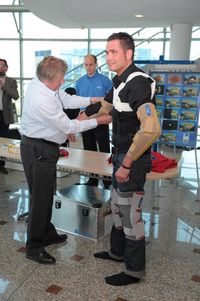Ford's Third Age Suit Helps Architects Design Homes For Elderly.
AACHEN, GERMANY - April 28, 2011 - With age comes wisdom. It's a pity that it also often brings along arthritis and a host of other well-known maladies and limitations.
Given the greying population in Europe and around the world, Ford Motor Company several years ago created the "Third Age Suit" – a specially designed suit that when worn by engineers, provides a visceral glimpse into the golden years.
The suit has helped Ford design cars that provided comfort and ease of usage for the young and old alike, including features like rear-view cameras, improved headroom and a better "H-point" – the point at which the hips swivel – to facilitate access to the interior.
Now the "Third Age Suit" is becoming a tool for European architects who are keen to design homes that meet the needs of older buyers.
A group of architects from Hahn & Helten GmbH recently visited Ford's Aachen research centre to try the suits for themselves, having seen media coverage of the innovation.
The home designers left with a better appreciation of what an older homeowner might need, such as how to design senior friendly stairs or why it's important to make seating higher so that the knee angle isn't more than 90 degrees – making it easier to stand up.
"For the first time, we intensively felt the restrictions of our target group and got a much closer understanding towards their real needs," the managing director of Aachen-based Hahn & Helten, GŁnter Helten, said.
"We are going to take what we've learned from this suit and apply those learnings in a practical manner so that our accommodation is the best it can possibly be for our elderly target market."
The young architects who tried on the Third Age Suit at Ford's European Research Centre in Aachen knew within 30 minutes what it was like to feel 30 years older. The suit has several features that significantly reduce the capability to move or that compromise the senses.
A kind of corset with shoulder straps strongly restricts flexibility of the upper body, particularly the hip region.
The so-called orthoses stiffen the knee and elbow joints as well as the feet to limit their movement. This impedes standing up, walking, and also grabbing and carrying things.
Usually, such orthoses are used by orthopedic surgeons to immobilise injured limbs after accidents and operations. A stiffened collar handicaps the turning of the head.
Latex gloves convey a limited sense of touch, which is often a consequence of diseases such as diabetes.
Fingerless mitts help young people to get a feeling for the lost power in the hands and the immobility of the fingers.
In addition, earplugs decrease the aural capabilities. Specially-designed glasses demonstrate the consequences of different eye diseases, including common disorders such as glaucoma and cataracts. In many cases, people lose the ability to see in three-dimensions. Monocular vision causes the loss of the ability to view 180 degrees.
Figures show that Europe's population is getting older. According to the 2009 Ageing Report by the European Commission and the Economic Policy Committee, across the 27 EU member states 17.2 per cent of the population was over the age of 65 – compared to 13.9 per cent in 1990.
And the prediction is that by 2060, 30 per cent of Europe's population will be over 65. The EU median age has also increased from 35.2 in 1990 to 40.7 in 2009, with it predicted to hit 47.9 by 2060.
"We developed this suit to show our engineers and designers what it feels like to be an older person," physician at the European Ford Research Centre, Dr Achim Linder, said.
"When you are young, you think you're designing for everybody, but you can't understand the range of people and their limitations. And you should always be aware that ageing is not a disease but a natural process of life."



